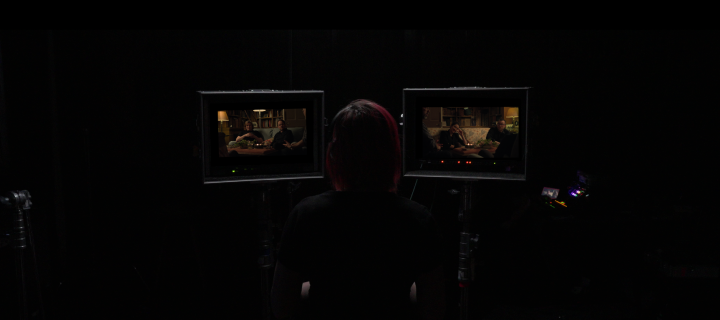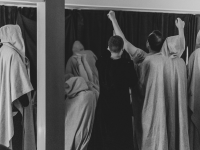Is it possible to capture the magic of larp on film? This was the question filmmaker Sophia Seymour and larp creator Martine Svanevik decided to explore in the spring of 2023.
As we write, we are three months into the edit, and the workings of a finished film is on the horizon. This article is part confessional, part conversation, and part inspiration for those of you who want to join us in trying to document and create something more permanent when we play.
We are the Remember that Time players and film crew, and we tried to create something new.
In 2019, Martine designed the larp Remember that Time. It’s a bittersweet piece about a group of friends that have stayed together through good times and bad. The friends meet up to reminisce after the death of one of the key members of their group, and the experience lends itself to feelings of reminiscing, grief, and catharsis.
Both Martine and Sophia felt that the larp had film potential. It was small and self-contained: and it dealt delicately with a tender yet important issue of grief, which lent itself to exploring the breadth and width of emotional bleed on film.

Readying the set for filming. Photo by Olivia Song.
To film a larp – you have to play it
Remember that Time was written as a black box larp and it only takes three hours. It can be played without costumes and has very few props. Originally, Martine wanted to lean into this black box nature of the larp, to shoot it on an empty stage with only a table. But after playing, Sophia and Edward, the cinematographer, had a different idea.
Edward Hamilton Stubber (Cinematographer): “After going out to Oslo to meet and play Remember that Time with Sophia, I was super inspired by the idea of filming a larp to see how far we could push the idea that something doesn’t need to be real to be felt.This is obviously true when we watch films as they are by their very nature dramatisations of fiction, yet we still feel something. But larp seems to offer a more visceral and personal experience of a given story, as instead of watching the story passively, you are part of it. I thought that if we could showcase the journey that participants go through in a larp, in a way that blurred lines with fiction filmmaking, then we might offer a reflection on why it is that we want to experience these emotions, in films and beyond.
Sophia: “After playing the game in Oslo and seeking counsel with some very helpful veteran larpers, we knew that comfort and safety were key to the success of the project. We knew we only had one chance to film the larp (larpers are not professional actors and there are no retakes) and so creating a safe environment for the larpers was key. This started well before we turned on the cameras and fed into every decision from where to film, how to film and what the eventual story would be. We had to treat the filming very carefully and had two somewhat contradictory main goals: to capture all the micro interactions and dynamics unfolding in the larp, and to make the larpers feel as comfortable and as little under observation as possible.”
Edward (Cinematographer): “The challenge for us was that we were going to be trying to create an atmosphere in front of the camera that didn’t disturb the authenticity of the larp. In conventional filmmaking, there is often a menagerie of different pieces of equipment and crew just outside of the frame lines, that are put in place to create a look and feeling that elevates the emotion of a given scene. But we knew that we couldn’t do this in the larp. We had to give all five participants the freedom to move around and explore the space without restriction, whilst also maintaining a look with lighting and camera movement that felt cinematic. This meant I had to put a lot of thought into where I would be placing cameras and lights, much more than I would have done in conventional film. It was a good challenge and I think it bore something unique.
Moreover, we decided to invite both crew and contributors to stay for the whole weekend in a large country house in the South of England to create a unique atmosphere of trust and collaboration. We played group bonding games and made sitting down for meals together a priority. By the end of the weekend we all felt like we had gone through an experience together, with each member of the crew and cast feeling like they were a part of a collaboration. This all contributed to the authenticity of the footage and veracity of the emotions on screen.”

Players and crew socializing outside of filming. Photo by Olivia Song.
Martine (larp designer and facilitator): “Unlike fiction film, the larp could only be shot in one take. How did you manage to capture all the dynamics while also filming so that the players didn’t feel the presence of the crew and kit?”
Edward: “We knew that we needed different camera angles in the edit to allow us to fit the three-hour game into a short film length. So as not to disturb the atmosphere of the game, we chose a room that had two adjoining rooms either side of it, which meant that I could light the game room and then have operators in total darkness operating cameras on sliders in the two other rooms, hunting for close-ups as the game developed. We also had three stationary cameras inside the room that were unmanned, which we used as broader catchall angles to use as a back-up in the edit.
This constellation kept the operators out of the eyelines of the participants, and I made sure to pump the main room with light so that once their eyes had compensated, the rooms either side appeared entirely dark. Myself and another colleague operated the cameras and it was quite thrilling – it felt like a mixture between live TV and fiction.”

Anna and Fredrik larping in front of the cameras. Still from the documentary.
To translate the story – you have to chop it up
Sophia (Film director): “Larp has sometimes been portrayed in a rather trite or negative light – were you ever nervous that the same might happen with this film?”
Martine: “Not after I met you. I thought the pitch for what you wanted to accomplish – to explore why we chase emotions when we experience art – was beautiful and interesting, and that you were approaching it in just the right way, so I wasn’t worried you would make the larpers look bad. What did worry me, however, was how moviemaking is about telling one story, whereas this larp – and most good larps, in my opinion – are about making every story equally important.
Since it’s difficult for audiences to equally care about everyone in a piece of fiction, I wondered how you would choose to frame what went on in the larp. Who would become the villain of the piece? Whose story would be told and whose would be lost? The larp lasts for three hours, and we were making a twenty-minute documentary. A lot of things would end up on the cutting-room floor, so what story would remain?
Although I never worried that you would approach it as a reality TV producer would, I was aware that the cutting, framing, and focus of the piece would change the story. “
Sophia: “I was also really concerned about where the editing process would take us. You often don’t know what is going to materialise in the cutting room and how to make sense of more than 20 hours of footage. My aim was to explore the impulse in Nordic larping to seek out emotional bleed through play. I knew there would be people who were unfamiliar with larp who might find it odd to play make-believe grief, but I was determined to make something that underlined how normal it is to seek out environments and situations that allow for feeling – be it at the theatre, in the cinema, or playing a larp.
To do this, I knew I did not want to sensationalise the game. It was about following the players’ emotional journey as faithfully as possible, rather than projecting my own version of events onto the film.”
Martine: “Do you think the documentary tells the story of the larp in a true way? What happened in the editing room? How do you feel about editing and changing the story to make it fit into a 20-minute documentary and tell a story that others can understand?”
Mariana Moraes (editor): “The editing of this documentary was the most difficult I’ve ever experienced, because in the footage the larp looks like bad acting. In movies, people rarely talk over each other and no-one stumbles looking for their next line. In this piece, the conversations were closer to the way real people speak, but that made them seem less truthful on camera.
Since the goal was to get the viewer to empathise with the emotional journey of the players inside the fiction, while also showing them that this was a game the players played, we had to find the balance between it feeling real (in a fictionalised way) and not real (since it is a game), without throwing off the audience. We struggled in early versions of the film with the ‘real’ feelings of grief that came off as fake or badly acted. So, in order to make those feelings feel as real as they were for the players in the game, we ended up drawing on the tools of fiction and cutting together the most ‘real’ moments.
It’s common to find the story of a documentary in the editing room, but in this case we had to experiment a lot more to find the film. The film plays with the audience’s perception: we had to experiment a lot with the drops of information we would release or withhold about what was happening. We wanted the audience to think in the beginning that the emotions they were watching were real, and by the end understand that emotions were real but not triggered by real events.

Still from the documentary.
The balance between over-telling and under-telling was our main challenge. At one point we had a conventional cut where we catered to an audience that had no understanding of larp. The focus in this cut became the players themselves – why do they play, how do they play, and what do they get out of it. This cut was an interesting showcase of why someone might larp, but it failed to take the audience on an emotional journey with the players.
Therefore, we ended up going with a version that required more active participation from the audience to fill in the blanks in order to understand the story. This lets us show more of the larp and join in with the players’ journey. We hope that the audience will still understand what is going on, even if they know less about what larp is and what exactly is happening.
Our hope is that we have created a comment on the power of storytelling and the way filmmaking and larping trigger emotions – be they real or not. It’s interesting because this version also allows the audience to project their own emotions and stories onto the film.”
Martine: “How did you approach the editing as a director?”
Sophia: “How to capture the essence of something and not get too bogged down in the minutiae of details and story threads became a huge question. I had to stay true to my vision that I wanted the audience to experience the larp rather than look at it. This was my compass.
We eventually landed on the idea that Martine would guide both players and audience through the game through a voiceover that takes us through the film. We realised that the audience needed to feel close to the players by relating to them as a group of old friends on a broader level, instead of following intricate story lines. We chose to include more abstract conversations – laughter, a little quip or a joke, a glance or a touch, which lent itself to feeling more immersive. We then intercut the larp with interviews with the players telling us how they were feeling during the larp, allowing the audience to follow the players’ emotional bleed.”
Martine: “One of the things I loved most about this process was that I wasn’t just running the larp, I was also invited to give feedback on the different cuts of the film and to join in the decision-making of the eventual story we were telling across the different mediums. This made me a more active part of the filmmaking process than I initially thought I would be, and I believe it is a strength of the final piece to have the larp designer’s input on the editing. I tried to always have the vision of the larp in mind when I looked at the footage, and tried to be the advocate of the larp inside the film.
We had to make hard choices about losing interesting stories in order to fit the documentary into 20 minutes. But at the same time, it was a good exercise in focusing on the essentials to build the narrative. For example, all the contributors had recent grief experiences in their real lives that influenced their bleed in the game, and those added a lot of nuance to the story. There wasn’t space to include all of them, however, and including one and leaving out the others felt like it shifted the focus of the story too much to what was happening with one of the players outside the larp.
The hardest for me was to come to terms with the fact that there wasn’t space for everyone’s emotional arc. Even though there were a lot of stories in the larp, the film did have to focus on one of them to keep the audience invested. However, we tried to balance it by showing more of the interviews and conversations happening during play, and I believe that we got the balance right, eventually. Nevertheless, if there’s ever a 90-minute version of this documentary, the story will be a lot more nuanced and many-faceted, and that is going to be even more beautiful.”

One of the larpers, Nadja, prepping for play. Still from the documentary.
Is it possible to play authentically while being on camera?
We knew the presence of the cameras and crew would be the main obstacle for us. We kept coming back to the same questions – would they make the players play differently? More stiff and awkward? Would they feel the need to perform in a different way than they normally would? Would the crew as an audience change the feel of the piece?
This is what our players said.
Frederik Hatlestrand (player): “It was a little bit surreal at first, but when I started playing, I kind of ignored the cameras because I’m used to playing in spaces where you have to ignore stuff. I’m just used to ignoring things that aren’t in there, so surprisingly I had some moments where I saw a camera and I was like, “Oh, yeah, it’s a camera. Okay, I’m looking another way now.” “
Anna Emilie Groth (player): “To be honest, I actually forgot pretty quickly (about the filming) because you did such a great job with hiding the cameras in the dark. I think there were only a few moments where I thought about it being a film set. It felt just like a black box larp. However, the experience that I had in the larp will not be what’s on the film, because it will never show the whole thing. But I’m really curious to see what the camera caught. I want to see what you can see from the outside. I’m not an actor, so I’m not used to seeing myself on film.”
Simon Brind (player): “I was super nervous about it for a number of reasons. The biggest reason was as I’ve said this before, that we’re not actors, we’re not used to performing. We’re certainly not used to cameras but incredibly I didn’t see them. It was very strange because when we went onto the set, there was a boom at head height which meant I had to be careful where I stood up, and there were cameras hidden by the windows and at the doors. But once the larp started they pretty much ceased to exist. I don’t think the filming affected what I was doing in the end, which makes me excited to see the end result.”
Erik Winther Paisley (player): “Maybe larp is not impossible to film. I don’t know yet. I have not seen it yet. The impossibility for me, I think, is whether our private states will actually come through enough, whether those little glances and moments that mean something for us will show. The example I give you is karaoke: you could document karaoke, but I think the worst possible way you could do that would be just to release an album of people’s karaoke singing.”

Larp creator Martine Svanevik (left) and filmmaker Sophia Seymour (right) on set. Photo by Olivia Song.
Can we capture the magic?
Martine: “Do you think we captured the magic of larp on camera?”
Sophia: “I hope so! We wanted the film to connect with both larpers and audiences who knew nothing about larp, and so have trod a fine line between throwing the audience into the deep end of the game and providing clues as to what this is all about. My secret is not in the filming of it – although Edward did a fantastic technical job in hiding the crew from the larp space – but the emphasis I placed on creating the right environment. I wanted to film in the perfect location where everyone could stay together to feel comfortable and safe.
Larp can be such a personal and vulnerable process that one of my priorities was to dedicate a large proportion of our budget on lodging and catering, to create a homely environment where crew and contributors could be together, sit around chatting, and get to know each other before filming. I firmly believe that these behind-the-scenes comforts meant that when we did begin filming there was a lot of trust between everyone involved. This in turn meant less nerves, less performance anxiety, and much more fun. I had the sense that we were all collaborating for a collective vision of the film, which I hope has translated on screen.”
Sophia (film director): “By the end, did you feel that we had captured the larp? What were your hopes and concerns?”
Martine: “I think the way you filmed the larp gave us a very good position to start from, and that it would be possible to tell many stories from the footage – all of them true even if none of them were real. We had to create an emotional story that the audience connected to and related to, while explaining what larp is to those that have never heard of it.
I got to watch every second of the larp on camera as it was played, and I know how beautiful the whole piece was, and there were of course stories that got lost in the translation from larp to film. However, the film shows the artform in a cinematic way, despite having to focus on only one or two character threads.
There are many possible stories you could have made from the footage, but I think you made the right editing choices in the end to create a cohesive whole. I am very happy that we stayed true to the vision of wanting to let the audience experience the larp and the emotional journey, rather than explain via the more traditional cut simply what larp is. Here, I think we might have captured something that speaks to how we all seek out and need to feel – perhaps even more than we tend to allow ourselves in everyday life.”
Sophia: “Where do you see this heading in the future?”
Martine: “I am super keen to try more transmedia stuff now, to try VR in game, to try filming parts of an experience and show it to players in different areas to see how they react, to have in-game confession booths active during play, etc. I think there are possibilities here to create something that transcends art forms. Nadja, one of our players, put it so well.”
Nadja Lipsyc (player): “I think it’s impossible to film what it is to larp. Because larpers are not actors. It might look just like bad acting and bad dialogue and cringe interactions on screen while the interaction in the larp feels entirely different. However, I think having larp as a layer in an artistic project is very interesting and very promising.”
Martine: “Would you do it again?”
Sophia (Film director): “Definitely! We learnt so much, the next time will be even better! Who’s up for it?”
The documentary Remember that Time will be released in February 2024.
This article has been reprinted with permission from the Solmukohta 2024 book. Please cite as:
Seymour, Sophia & Martine Svanevik. 2024. “Remember That Time… We Tried to Film a Larp.” In Liminal Encounters: Evolving Discourse in Nordic and Nordic Inspired Larp, edited by Kaisa Kangas, Jonne Arjoranta, and Ruska Kevätkoski. Helsinki, Finland: Ropecon ry.
Cover photo: Backstage while filming the documentary. Photo by Olivia Song. Photo has been cropped.






